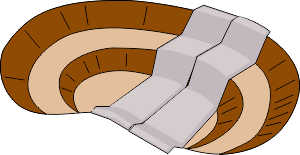This guide will take you through the steps necessary to install a pond liner successfully. However, before you start, it's worth reading our Pond Design Guide. The guide will help you with pond layout, edging ideas and much more.
If you still haven't purchased your pond liner yet, read our Pond Liner Guide to find the most suitable material for your garden pond project. You can also shop Pond liners here and you may find our Pond Liner Size Calculator helpful.
Step 1: Dig the hole to the required shape, taking care to make the sides sloping rather than vertical. To create planting areas for marginal plants, leave steps from 20 cm to 40 cm deep as required (as shown in the illustration). For a perfect finish, ensure that the top edge of the pool is level. This will make edging the pool easier with minimal visible liner exposed.

Step 2: Ensure the pool area is free from sharp stones. Then place underlay on the base and sides of the excavation before positioning your liner in position. Lightly anchor the liner in position with bricks evenly distributed around the edge of the liner, not the hole (avoiding the anchors being pulled into the pond). Should you need to tread on the liner, remove shoes to prevent piercing.

Step 3: Run water into the pool gradually, whilst at the same time pulling and tucking the liner into shape to ensure a neat finish. You’ll notice that the liner will stretch at first, then as the weight of water increases, it will mould itself to the shape of the sides.

Step 4: Once the pond is filled leave for at least 24 hours to ensure proper settlement of the liner. Trim off excess liner around the pool with scissors or a knife, leaving 30cm overlap for anchorage.

Step 5: After a week, complete your pool by edging in stone or paving as desired (see edging ideas), allowing for a slight overhang to hide any exposed liner from direct sunlight.

HOWEVER much planning goes into creating a pond, poor edging can spoil the finished effect and look unsightly, as well as possibly leaving liners exposed to direct sunlight. This can cause the liner to perish, hence shortening its life expectancy and allowing it to become more vulnerable to accidental damage.